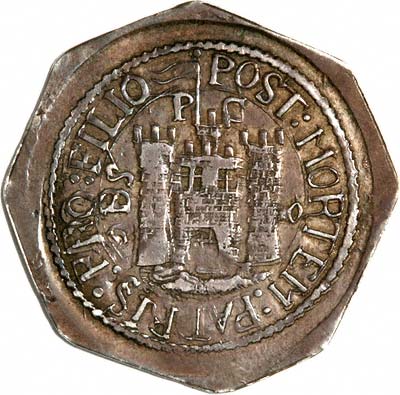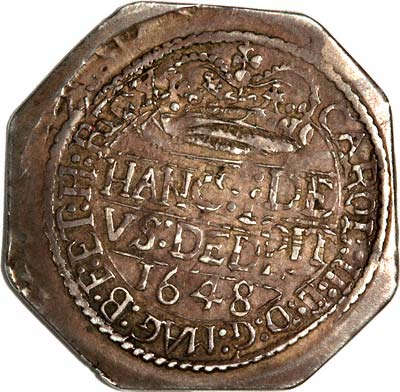
Obverse (front)

Reverse
From England, Carlisle (AD 1645), Scarborough (1645), Newark (1646), and Pontefract (1648)Issued by towns loyal to the king.
The end of the civil war in 1646 left parliament fully in control . however, though not as serious and widespread as before , war broke out again in 1648 . an uprising in Wales was crushed and soon afterwards royalist supporters at Colchester were forced to surrender . in the north opposition to parliament centred on Pontefract ,where the castle provided a base for royalists . however, parliament's new model army was disciplined and well organized and before the royalists could expand their Pontefract castle was placed under siege . during the first period of civil war several mints were set up to provide the currency needed by supporters of Charles 1st , only one place struck silver coins during the second outbreak- Ponterfract Castle, whilst it was surrounded by parliamentarian troops . A few gold coins were struck but production mainly centred on silver shillings , which were either round , octagonal or lozenge- shaped. Two shilling pieces were also struck but few can have been made for they are now excessively rare...............
Silver Siege Money Coins
Emergency coinage and money has been made on numerous occasions throughout history, when towns were under siege. These were often crudely produced, but are often of more interest to historians and numismatists than regular coinage.
Under Charles I, siege money was made at a number of provincial mints, Pontefract being one of them.
Our photographs show a very interesting Pontefract shilling of 1648.
The Tower Mint had been under the control of the king from 1625 to 1642, after that it came under the control of Parliament. In addition to the Tower Mint in London, other provincial mints which operated in royalist areas under the King included Carlisle, Scarborough, Pontefract, Newark, Chester, Ashby-de-la-Zouch, Shrewsbury, Aberystwyth, Bridgnorth, Hartlebury Castle, Worcester, Hereford, Oxford, Bristol and Exeter.
Obverse:
View of Pontefract Castle before it was demolished, with OBS PC to the left and top of the castle.
The motto of the town of Pontefract is shown as the legend of this coin.
POST MORTEM PATRIS PRO FILIO
(After the death of the father for the son).
We do not know when this became the Pontefract motto, or when it was first used, but it may very well have been on these siege money pieces, indeed this is almost certainly the case.
The Wakefield Council website states the motto to have been adopted by Pontefract "some time after the Restoration in the reign of Charles II".
Reverse:
Crowned inscription in three lines:
HANC DE
US DEDIT

1648 Pomfret Castle on Obverse of 1648 Charles I Pontefract Shilling

(HANC Deus DEDIT 1648) (God has given it). Reverse of 1648 Charles I Pontefract Shilling
The legend reads:
CAROL. II. D.G. MAG. B.F.ET.H. REX
An Anomaly
The coin is clearly dated 1648, and would have been struck during the third siege, (the first two being short affairs in 1645). Charles I died on December 30th 1649, so the reference to Charles II in the legend, and the motto, constitute an anachronism when compared with the date stamped on the coin, which would not have borne Charles II's name until after the death of his father, so probably during 1650.
It could be argued that, as emergency money, produced under abnormal circumstances, that the obverse was paired with an oder existing reverse die, except for the fact that the reverse is named for Charles II.
Broken Bridge, Tower, and Pontefract Cakes
The name Pontefract comes from Latin, and means "broken bridge". Perhaps now it is more famous for its broken castle, it should be renamed.
In Norman times, the town was known as Pomfret, which we think may have been due to a Francophone pronunciation of Pontefract. Images of the castle can still be seen on one of the town's most famous products, "Pomfret Cakes". These are liquorice sweets, which are still made in the town, but which have their origins in liquorice cakes produced by monks, presumably for medicinal or health purposes, from liquorice grown locally.
Liquorice (Glycyrrhiza glabra) in the family Leguminosae is a tall shrub (4.5 feet; 140 cm) with blue or violet flowers. Glycyrrhiza comes from the Greek and means "sweet root".
